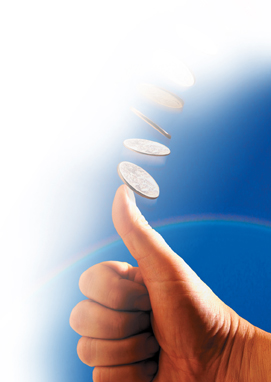11.2 Applying Mendel's Principles
 How can we use probability to predict traits?
How can we use probability to predict traits? How do alleles segregate when more than one gene is involved?
How do alleles segregate when more than one gene is involved? What did Mendel contribute to our understanding of genetics?
What did Mendel contribute to our understanding of genetics?
probability • homozygous • heterozygous • phenotype • genotype • Punnett square • independent assortment
Preview Visuals Before you read, preview Figure 11–7. Try to infer the purpose of this diagram. As you read, compare your inference to the text. After you read, revise your statement if needed or write a new one about the diagram's purpose.
THINK ABOUT IT Nothing in life is certain. There's a great deal of wisdom in that old saying, and genetics is a fine example. If a parent carries two different alleles for a certain gene, we can't be sure which of those alleles will be inherited by any one of the parent's offspring. However, think carefully about the nature of inheritance and you'll see that even if we can't predict the exact future, we can do something almost as useful—we can figure out the odds.
Probability and Punnett Squares
 How can we use probability to predict traits?
How can we use probability to predict traits?
Whenever Mendel performed a cross with pea plants, he carefully categorized and counted the offspring. Consequently, he had plenty of data to analyze. For example, whenever he crossed two plants that were hybrids for stem height (Tt), about three fourths of the resulting plants were tall and about one fourth were short.
Upon analyzing his data, Mendel realized that the principles of probability could be used to explain the results of his genetic crosses. Probability is a concept you may have learned about in math class. It is the likelihood that a particular event will occur. As an example, consider an ordinary event, such as flipping a coin. There are two possible outcomes of this event: The coin may land either heads up or tails up. The chance, or probability, of either outcome is equal. Therefore, the probability that a single coin flip will land heads up is 1 chance in 2. This amounts to 1/2, or 50 percent.
If you flip a coin three times in a row, what is the probability that it will land heads up every time? Each coin flip is an independent event with a 1/2 probability of landing heads up. Therefore, the probability of flipping three heads in a row is:

As you can see, you have 1 chance in 8 of flipping heads three times in a row. The multiplication of individual probabilities illustrates an important point: Past outcomes do not affect future ones. Just because you've flipped three heads in a row does not mean that you're more likely to have a coin land tails up on the next flip. The probability for that flip is still 1/2.

FIGURE 11–6 Probability Probability allows you to calculate the likelihood that a particular event will occur. The probability that the coin will land heads up is ½, or 50 percent.

Table of Contents
- Formulas and Equations
- Applying Formulas and Equations
- Mean, Median, and Mode
- Estimation
- Using Measurements in Calculations
- Effects of Measurement Errors
- Accuracy
- Precision
- Comparing Accuracy and Precision
- Significant Figures
- Calculating With Significant Figures
- Scientific Notation
- Calculating With Scientific Notation
- Dimensional Analysis
- Applying Dimensional Analysis




